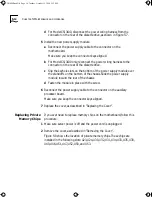
4-8
C
HAPTER
4: C
ONFIGURATION
Address discovery obtains the information listed in this menu either through
static entries configured in firmware by the user, or by BOOTstrap Protocol
(BOOTP) or Reverse Address Resolution Protocol (RARP) from another source
during system boot. The discovery protocol you choose defines how much
additional information you must provide.
If you choose static entries (local information), no information is discovered;
you must enter all IP addressing parameters yourself. If you choose RARP, the
communications server provides its Ethernet address in an RARP request
message. The boot server maps this address into the corresponding IP add-
ress and returns it to the communications server in an RARP reply message.
The mapping resides in the “ethers” and “hosts” databases, contained either in
files under the /etc directory or in Network Information Service (NIS) maps.
BOOTP is similar to RARP but can return more information.
The Address Discovery option also determines how the communications
server downloads files from the boot server. If BOOTP is used, the filename to
download is obtained from the BOOTP server. If RARP or Local Inform- ation is
used, the server attempts a TFTP download of the file named in the Network
Boot String parameter. Table 4-2 lists Address Discovery Protocol parameter
options and their meaning.
If you select a value that includes BOOTP, you must add a corresponding entry
to the bootptab file on the boot server. This file is usually found in the /etc
directory, but its location may vary depending on your operating system and
TFTP software.
2
To specify other IP address parameters, type the letter for the parameter.
These parameters allow you greater control over booting your server, and are
required if Address Discovery Protocol is “Local Information.” Table 4-3 lists the
additional IP parameters and information for specifying them.
Table 4-2
Address Discovery Protocol Parameters
Value
Meaning
BOOTP
BOOTP only.
BOOTP then RARP
The communications server first seeks TFTP server addresses
using BOOTP; if this fails, it tries RARP. This is the default.
RARP
RARP only.
RARP then BOOTP
The communications server first seeks addresses using RARP; if
this fails, it tries BOOTP.
Local Information
The communications server obtains addresses from static entries.
CS3000BookFile Page 8 Tuesday, October 15, 1996 5:12 PM
















































